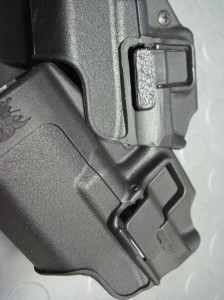Widgetized Section
Go to Admin » Appearance » Widgets » and move Gabfire Widget: Social into that MastheadOverlay zone
Instructor Skills and SERPA Bashing
 My wife wonders why I still attend training courses at this stage of my life. “What could you possibly learn that you have not already heard?” she often asks. The truth is I don’t know what I don’t know so I continue to seek out additional knowledge. That said, I seldom hear anything new and all too often what I do hear is some instructor trying to spin old doctrine into new doctrine by making it sound “Special Operations-like”. The harsh reality is there are only so many ways to shoot a gun and they have all been invented. My friend Kelly McCann says, “If you want to learn something new, read an old book” which sounds a lot like what my grandmother used to say, “Just hang on, what is old will be new again…and someone smooth will try to sell it to you!” Man, was she right!
My wife wonders why I still attend training courses at this stage of my life. “What could you possibly learn that you have not already heard?” she often asks. The truth is I don’t know what I don’t know so I continue to seek out additional knowledge. That said, I seldom hear anything new and all too often what I do hear is some instructor trying to spin old doctrine into new doctrine by making it sound “Special Operations-like”. The harsh reality is there are only so many ways to shoot a gun and they have all been invented. My friend Kelly McCann says, “If you want to learn something new, read an old book” which sounds a lot like what my grandmother used to say, “Just hang on, what is old will be new again…and someone smooth will try to sell it to you!” Man, was she right!
What I like to do is listen to an instructor explain why they think as they do, especially if their thought process is based on real world experience. I have heard it said that street or battlefield experience is not critical to be a shooting instructor and this is true…if all that is taught is shooting. However, if an instructor is teaching how to fight with a gun, having been in an event in which someone was trying, to the best of their ability, to end their life offers a perspective the non-tested instructor cannot comprehend. One can usually tell the instructor who has fought for their life…all that “ninja-fied” cool looking crap that is all the rage these days is not present in their lesson plan. Their techniques are simple, straight forward and easy to adopt into one’s skill set. Why? Because these instructors understand the complexities of conflict and know to keep it simple! Big words, ninja gear and slick looking techniques just don’t cut it.
The most gifted instructors have the ability to be verbally/visually descriptive…they can explain something in such a way that a student can get a picture in their mind of what is being presented. Thus, I am always looking for new ways to say something and for articulated reasons behind a given doctrine. The gifted trainer is a teacher, one who imparts knowledge and has the ability to not only explain, but can also demonstrate the skill in question. The best instructors can also agree to disagree with another by giving their reasons why they like something in such a way that it makes sense to the less informed. Just saying “this is how we have always done it” or “Because I (or some other instructor Guru) say so” is not good enough…at least for me.
It has become popular of late to bash Blackhawk’s SERPA holster as unsafe and while I understand the concern expressed, it simply is not true. The mishaps that have occurred with the SERPA are shooter error not a poor holster design. There… I have said it. Before I move forward understand that I do not work for Blackhawk, receive NO money from them nor do I have personal ties to the company other than I like much of their product line. I just happen to think the SERPA is a physiologically efficient holster design if retention is a desired feature. I have had many security holsters over the last 35 years. My first duty rig was a “suicide strap” swivel holster that quickly turned into a thumb break rig. I had both versions of the Bianchi front break revolver holster and when pistols became the standard, I had all the rock back, pull forward, turn outward, rotate over , hit this snap-turn-pull, jerk, slap, tug, pivot and every other security device available. What I could not help but notice is when the gun is secure from a gun grabber; it is also secure from me!
When the SERPA was first introduced I liked how intuitive the design was. It was the first multiple threat level holster that released its security devices consistent with the way the hand wraps around the grip to achieve a solid firing grip. There was no rotating this, pushing that, twisting, tugging, etc. The thumb went to the rear of the gun and pushed a button while the trigger finger was kept straight releasing a second device while it did so. What could be easier? The concealment version does not have the thumb release but is still released via the use of a straight trigger finger and this is where the problems begin.
Shooters who do not commit the required practice to the design begin to doubt their ability to push the index finger release button while quickly drawing so they turn the finger inward using the tip to depress the button which results in a trigger finger poised to enter the trigger guard as the gun is drawn. By doing this the shooter is using the SERPA improperly. There are ways to fix this if you like the idea of the SERPA but are concerned about your ability to hit the button during a crisis event. The first is to build up the button so it is easy to find. I have done this using GOOP, the well known rubber glue that was first marketed as SHOE GOO. Clean the SERPA button with alcohol and use masking tape to create a dam around the edge of the button. Fill the area with GOOP and let it dry. Once dry, make sure the taller button clears the edge of the holster when depressed. If not, use a craft knife or other sharp blade to trim excess. Stick a piece of skate board tape on top of the GOOP and you will have a button that is easy to depress.
Another way to raise the profile of the button is to block the SERPA button inward and remove the plastic guard that is molded into the holster at the forward edge (see photo). This allows the button to extend outward making it easier to hit. The last option is to practice with the holster until you can’t get it wrong. Remember the definition of a professional? A professional practices until they can’t get it wrong while an amateur practices until they get it right. Big difference if you stop to think about it. Can I understand why some instructors are banning the SERPA? Sure, if improperly used the SERPA can create an unsafe condition in their class and they really don’t want to test their liability insurance. I just believe an instructor does not only impart knowledge and build skills; he/she should also offer solutions for real world problems.
Stay safe and check your 360 often!
 Dave Spaulding is the 2010 Law Officer Trainer of the Year and Law Officer’s Firearms columnist. A 28-year law enforcement veteran who retired at the rank of lieutenant, he is the founder of Handgun Compatives. He has worked in corrections, communications, patrol, evidence collection, investigations, undercover operations, training and SWAT—and has authored more than 1,000 articles for various firearms and law enforcement periodicals. He’s also the author of the best-selling books Defensive Living and Handgun Combatives. Visit his web site at www.handguncombatives.com and like him on Facebook.
Dave Spaulding is the 2010 Law Officer Trainer of the Year and Law Officer’s Firearms columnist. A 28-year law enforcement veteran who retired at the rank of lieutenant, he is the founder of Handgun Compatives. He has worked in corrections, communications, patrol, evidence collection, investigations, undercover operations, training and SWAT—and has authored more than 1,000 articles for various firearms and law enforcement periodicals. He’s also the author of the best-selling books Defensive Living and Handgun Combatives. Visit his web site at www.handguncombatives.com and like him on Facebook.
7 Responses to Instructor Skills and SERPA Bashing
You must be logged in to post a comment Login



 MidwayUSA
MidwayUSA Ruger Firearms
Ruger Firearms SCCY Firearms
SCCY Firearms Streamlight
Streamlight Action Targets
Action Targets Gunsite Academy
Gunsite Academy
Pingback: On SERPAs and Solutions | Down Range TV